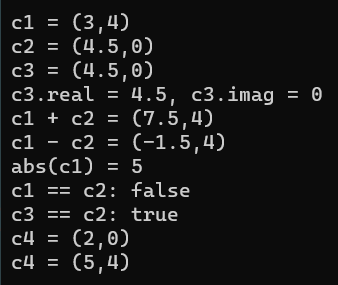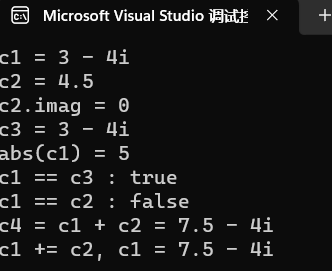1.实验任务1:
实验源代码:
1 // 标准库string, vector, array基础用法 2 #include <iostream> 3 #include <string> 4 #include <vector> 5 #include <array> 6 // 函数模板 7 // 对满足特定条件的序列类型T对象,使用范围for输出 8 template<typename T> 9 void output1(const T& obj) { 10 for (auto i : obj) 11 std::cout << i << ", "; 12 std::cout << "\b\b \n"; 13 } 14 // 函数模板 15 // 对满足特定条件的序列类型T对象,使用迭代器输出 16 template<typename T> 17 void output2(const T& obj) { 18 for (auto p = obj.begin(); p != obj.end(); ++p) 19 std::cout << *p << ", "; 20 std::cout << "\b\b \n"; 21 } 22 // array模板类基础用法 23 void test_array() { 24 using namespace std; 25 array<int, 5> x1; // 创建一个array对象,包含5个int元素,未初始化 26 cout << "x1.size() = " << x1.size() << endl; // 输出元素个数 27 x1.fill(42); // 把x1的所有元素都用42填充 28 x1.at(0) = 999; // 把下标为0的元素值修改为999 29 x1[4] = -999; // 把下表为4的元素值修改为-999 30 cout << "x1: "; 31 output1(x1); // 调用模板函数output1输出x1 32 cout << "x1: "; 33 output2(x1); // 调用模板函数output1输出x1 34 array<int, 5> x2{x1}; 35 cout << boolalpha << (x1 == x2) << endl; 36 x2.fill(22); 37 cout << "x2: "; 38 output1(x2); 39 swap(x1, x2); // 交换array对象x1, x2 40 cout << "x1: "; 41 output1(x1); 42 cout << "x2: "; 43 output1(x2); 44 } 45 // vector模板类基础用法 46 void test_vector() { 47 using namespace std; 48 vector<int> v1; 49 cout << v1.size() << endl; // 输出目前元素个数 50 cout << v1.max_size() << endl; // 输出元素个数之最大可能个数 51 v1.push_back(55); // 在v1末尾插入元素 52 cout << "v1: "; 53 output1(v1); 54 vector<int> v2 {1, 0, 5, 2}; 55 v2.pop_back(); // 从v2末尾弹出一个元素 56 v2.erase(v2.begin()); // 删除v2.begin()位置的数据项 57 v2.insert(v2.begin(), 999); // 在v1.begin()之前的位置插入 58 v2.insert(v2.end(), -999); // 在v1.end()之前的位置插入 59 cout << v2.size() << endl; 60 cout << "v2: "; 61 output2(v2); 62 vector<int> v3(5, 42); //创建vector对象,包含5个元素,每个元素值都是42 63 cout << "v3: "; 64 output1(v3); 65 vector<int> v4(v3.begin(), v3.end() - 2); // 创建vector对象,以v3对象的[v3.begin(), v3.end() - 2)区间作为元素值 66 cout << "v4: "; 67 output1(v4); 68 } 69 // string类基础用法 70 void test_string() { 71 using namespace std; 72 string s1{ "oop" }; 73 cout << s1.size() << endl; 74 for (auto& i : s1) 75 i -= 32; 76 s1 += "2023"; 77 s1.append(", hello"); 78 cout << s1 << endl; 79 } 80 int main() { 81 using namespace std; 82 cout << "===========测试1: array模板类基础用法===========" << endl; 83 test_array(); 84 cout << "\n===========测试2: vector模板类基础用法===========" << endl; 85 test_vector(); 86 cout << "\n===========测试3: string类基础用法===========" << endl; 87 test_string(); 88 }
运行测试截图:

2.实验任务2:
实验源代码:
1 #include <iostream> 2 #include <complex> 3 // 测试标准库提供的复数类模板complex 4 void test_std_complex() { 5 using namespace std; 6 complex<double> c1{3, 4}, c2{ 4.5 }; 7 const complex<double> c3{c2}; 8 cout << "c1 = " << c1 << endl; 9 cout << "c2 = " << c2 << endl; 10 cout << "c3 = " << c3 << endl; 11 cout << "c3.real = " << c3.real() << ", " << "c3.imag = " << c3.imag() 12 << endl; 13 cout << "c1 + c2 = " << c1 + c2 << endl; 14 cout << "c1 - c2 = " << c1 - c2 << endl; 15 cout << "abs(c1) = " << abs(c1) << endl; // abs()是标准库数学函数,对复数取模 16 cout << boolalpha; // 设置bool型值以true/false方式输出 17 cout << "c1 == c2: " << (c1 == c2) << endl; 18 cout << "c3 == c2: " << (c3 == c2) << endl; 19 complex<double> c4 = 2; 20 cout << "c4 = " << c4 << endl; 21 c4 += c1; 22 cout << "c4 = " << c4 << endl; 23 } 24 int main() { 25 test_std_complex(); 26 }
运行测试截图:

3.实验任务3:
实验源代码:
1 // 一个简单的类T:定义、使用 2 #include <iostream> 3 #include <string> 4 using namespace std; 5 // 类T的声明 6 class T { 7 public: 8 T(int x = 0, int y = 0); // 带有默认形值的构造函数 9 T(const T& t); // 复制构造函数 10 T(T&& t); // 移动构造函数 11 ~T(); // 析构函数 12 void set_m1(int x); // 设置T类对象的数据成员m1 13 int get_m1() const; // 获取T类对象的数据成员m1 14 int get_m2() const; // 获取T类对象的数据成员m2 15 void display() const; // 显示T类对象的信息 16 friend void func(); // 声明func()为T类友元函数 17 private: 18 int m1, m2; 19 public: 20 static void disply_count(); // 类方法,显示当前T类对象数目 21 public: 22 static const string doc; // 类属性,用于描述T类 23 static const int max_count; // 类属性,用于描述T类对象的上限 24 private: 25 static int count; // 类属性,用于描述当前T类对象数目 26 }; 27 // 类的static数据成员:类外初始化 28 const string T::doc{"a simple class"}; 29 const int T::max_count = 99; 30 int T::count = 0; 31 // 类T的实现 32 T::T(int x, int y) : m1{ x }, m2{ y } { 33 ++count; 34 cout << "constructor called.\n"; 35 } 36 T::T(const T& t) : m1{ t.m1 }, m2{ t.m2 } { 37 ++count; 38 cout << "copy constructor called.\n"; 39 } 40 T::T(T&& t) : m1{ t.m1 }, m2{ t.m2 } { 41 ++count; 42 cout << "move constructor called.\n"; 43 } 44 T::~T() { 45 --count; 46 cout << "destructor called.\n"; 47 } 48 void T::set_m1(int x) { 49 m1 = x; 50 } 51 int T::get_m1() const { 52 return m1; 53 } 54 int T::get_m2() const { 55 return m2; 56 } 57 void T::display() const { 58 cout << m1 << ", " << m2 << endl; 59 } 60 // 类方法 61 void T::disply_count() { 62 cout << "T objects: " << count << endl; 63 } 64 // 友元函数func():实现 65 void func() { 66 T t1; 67 t1.set_m1(55); 68 t1.m2 = 77; // 虽然m2是私有成员,依然可以直接访问 69 t1.display(); 70 } 71 // 测试 72 void test() { 73 cout << "T class info: " << T::doc << endl; 74 cout << "T objects max_count: " << T::max_count << endl; 75 T::disply_count(); 76 T t1; 77 t1.display(); 78 t1.set_m1(42); 79 T t2{ t1 }; 80 t2.display(); 81 T t3{ std::move(t1) }; 82 t3.display(); 83 t1.display(); 84 T::disply_count(); 85 } 86 // 主函数 87 int main() { 88 cout << "============测试类T============" << endl; 89 test(); 90 cout << endl; 91 cout << "============测试友元函数func()============" << endl; 92 func(); 93 }
运行测试截图:

4实验任务4:
实验源代码:
#include <iostream> #include <string> #include <iomanip> using namespace std; class Rect { private: static int size; public: static const string doc; static int size_info() { return size; } friend void test(); private: double length, width; public: Rect(double l = 2.0, double w = 1.0) : length{ l }, width{ w } { size++; } Rect(const Rect& obj) : length{ obj.length }, width{ obj.width } { size++; } ~Rect() { size--; } double len() const { return length; } double wide() const { return width; } double area() const { return length * width; } double circumference() const { return 2 * (length + width); } void resize(double times) { length *= times; width *= times; } void resize(double l_times, double w_times) { length *= l_times; width *= w_times; } }; int Rect::size = 0; const string Rect::doc{"a simple Rect class"}; void output(const Rect& r) { cout << "矩形信息: " << endl; cout << fixed << setprecision(2); cout << "长: \t" << r.len() << endl; cout << "宽: \t" << r.wide() << endl; cout << "面积: \t" << r.area() << endl; cout << "周长: \t" << r.circumference() << endl; } void test() { cout << "矩形类信息: " << Rect::doc << endl; cout << "当前矩形对象数目: " << Rect::size_info() << endl; Rect r1; output(r1); Rect r2(4, 3); output(r2); Rect r3(r2); r3.resize(2); output(r3); r3.resize(5, 2); output(r3); cout << "当前矩形对象数目: " << Rect::size_info() << endl; } int main() { test(); cout << "当前矩形对象数目: " << Rect::size_info() << endl; }
运行测试截图:

5.实验任务5:
实验源代码:
#include <iostream>
#include <cmath>
class Complex {
private:
double real, imag;
public:
Complex(double r = 0, double i = 0) : real{ r }, imag{ i } {};
Complex(const Complex& c) :real{ c.real }, imag{ c.imag } {};
double get_real() const {
return real;
}
double get_imag() const {
return imag;
}
void add(const Complex& c) {
real += c.get_real();
imag += c.get_imag();
}
void show() {
std::cout << real;
if (imag > 0) std::cout << " + " << abs(imag) << 'i';
if (imag < 0) std::cout << " - " << fabs(imag) << 'i';
}
void show() const {
std::cout << real;
if (imag > 0) std::cout << " + " << abs(imag) << 'i';
if (imag < 0) std::cout << " - " << fabs(imag) << 'i';
}
public:
friend Complex add(const Complex&, const Complex&);
friend bool is_equal(const Complex&, const Complex&);
friend double abs(const Complex&);
};
Complex add(const Complex& c1, const Complex& c2) {
double r, i;
r = c1.get_real() + c2.get_real();
i = c1.get_imag() + c2.get_imag();
Complex c(r, i);
return c;
}
bool is_equal(const Complex& c1, const Complex& c2) {
bool r, i;
r = c1.get_real() == c2.get_real();
i = c1.get_imag() == c2.get_imag();
return r && i;
}
double abs(const Complex& c) {
return sqrt(pow(c.get_real(), 2) + pow(c.get_imag(), 2));
}
void test() {
using namespace std;
Complex c1(3, -4);
const Complex c2(4.5);
Complex c3(c1);
cout << "c1 = ";
c1.show();
cout << endl;
cout << "c2 = ";
c2.show();
cout << endl;
cout << "c2.imag = " << c2.get_imag() << endl;
cout << "c3 = ";
c3.show();
cout << endl;
cout << "abs(c1) = ";
cout << abs(c1) << endl;
cout << boolalpha;
cout << "c1 == c3 : " << is_equal(c1, c3) << endl;
cout << "c1 == c2 : " << is_equal(c1, c2) << endl;
Complex c4;
c4 = add(c1, c2);
cout << "c4 = c1 + c2 = ";
c4.show();
cout << endl;
c1.add(c2);
cout << "c1 += c2, " << "c1 = ";
c1.show();
cout << endl;
}
int main() {
test();
}
运行测试截图:
